Human Resource Management Report: ASDA Retail Sector Analysis
VerifiedAdded on 2023/02/02
|13
|3746
|78
Report
AI Summary
This report provides a comprehensive analysis of Human Resource Management (HRM) practices within the retail sector, specifically focusing on ASDA. The report begins with an introduction to HRM, outlining its roles and purposes, and then delves into the strengths and weaknesses of various recruitment and selection approaches. It further explores the benefits of different HRM practices for both employers and employees, evaluating their effectiveness in enhancing organizational productivity and employee satisfaction. The report also emphasizes the importance of employee relations, discussing key elements of employee legislation and concluding with a review of job descriptions and person specifications. The report includes internal and external recruitment processes, selection processes, and employee relations within the organization. It also contains the benefits of HRM practices for employees, including employee turnover, conflict resolutions, and employee satisfaction. The report uses Harvard referencing method.

HUMAN RESOURCE
management
Contents
management
Contents
Paraphrase This Document
Need a fresh take? Get an instant paraphrase of this document with our AI Paraphraser
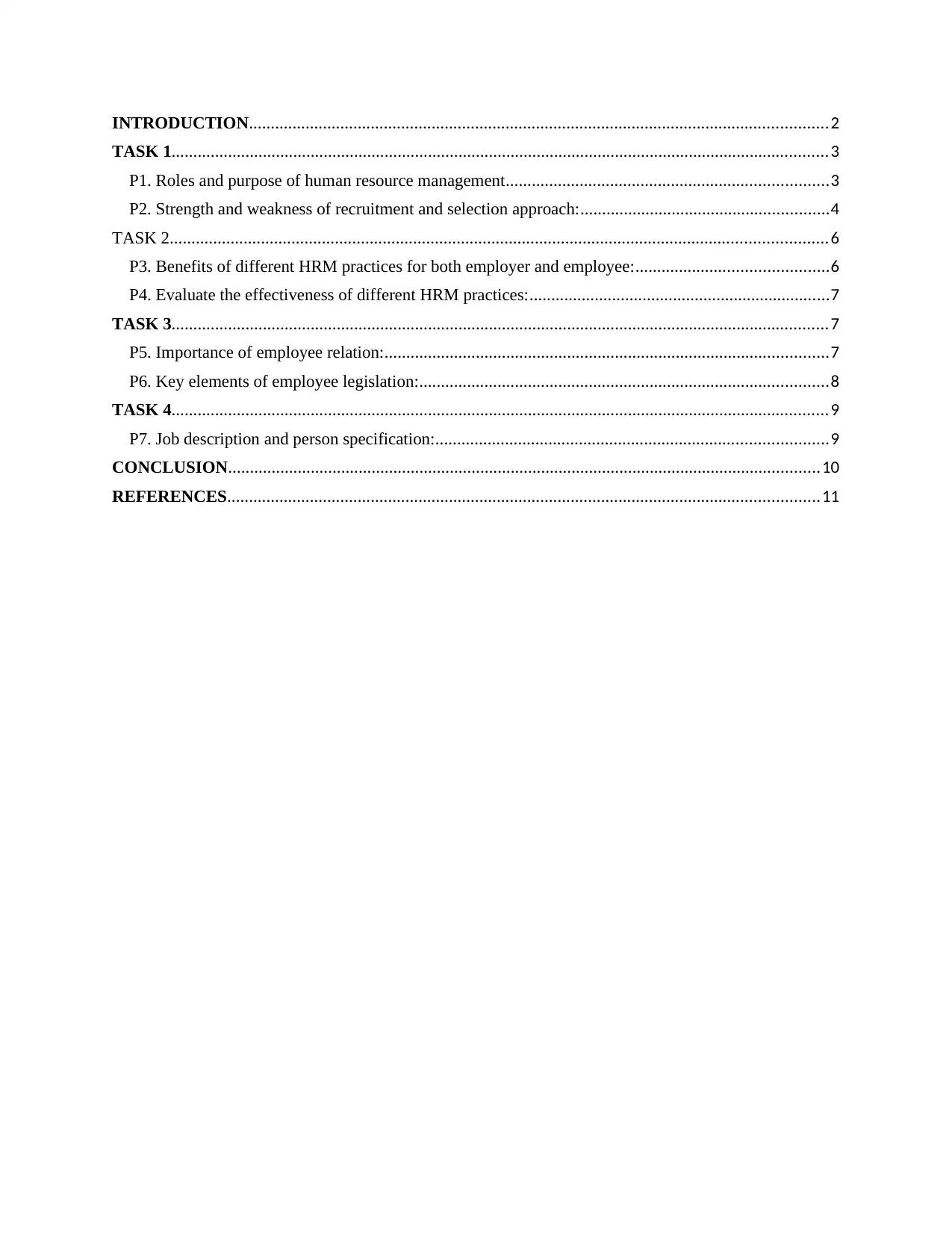
INTRODUCTION.....................................................................................................................................2
TASK 1.......................................................................................................................................................3
P1. Roles and purpose of human resource management..........................................................................3
P2. Strength and weakness of recruitment and selection approach:.........................................................4
TASK 2.......................................................................................................................................................6
P3. Benefits of different HRM practices for both employer and employee:............................................6
P4. Evaluate the effectiveness of different HRM practices:.....................................................................7
TASK 3.......................................................................................................................................................7
P5. Importance of employee relation:......................................................................................................7
P6. Key elements of employee legislation:..............................................................................................8
TASK 4.......................................................................................................................................................9
P7. Job description and person specification:..........................................................................................9
CONCLUSION........................................................................................................................................10
REFERENCES........................................................................................................................................11
TASK 1.......................................................................................................................................................3
P1. Roles and purpose of human resource management..........................................................................3
P2. Strength and weakness of recruitment and selection approach:.........................................................4
TASK 2.......................................................................................................................................................6
P3. Benefits of different HRM practices for both employer and employee:............................................6
P4. Evaluate the effectiveness of different HRM practices:.....................................................................7
TASK 3.......................................................................................................................................................7
P5. Importance of employee relation:......................................................................................................7
P6. Key elements of employee legislation:..............................................................................................8
TASK 4.......................................................................................................................................................9
P7. Job description and person specification:..........................................................................................9
CONCLUSION........................................................................................................................................10
REFERENCES........................................................................................................................................11
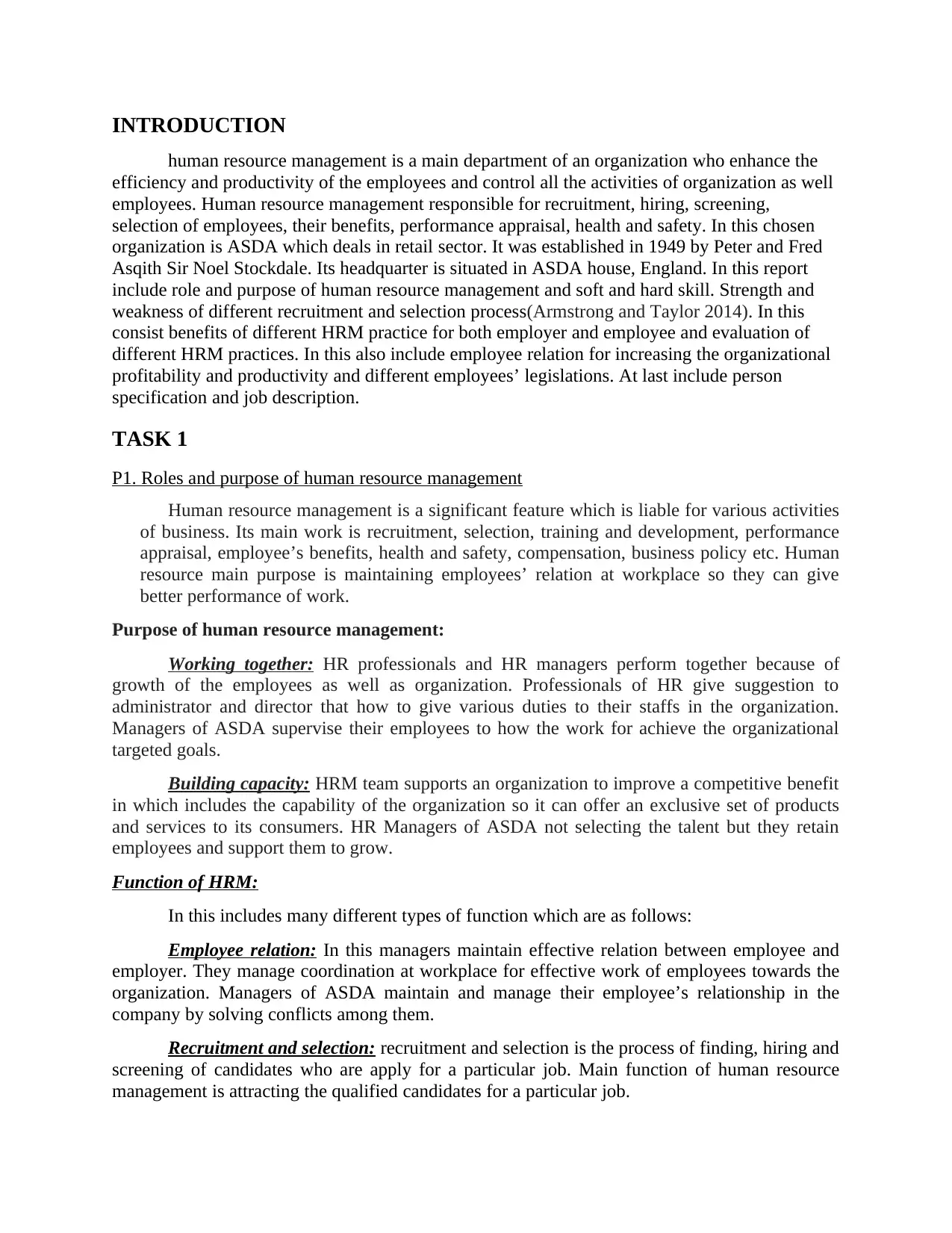
INTRODUCTION
human resource management is a main department of an organization who enhance the
efficiency and productivity of the employees and control all the activities of organization as well
employees. Human resource management responsible for recruitment, hiring, screening,
selection of employees, their benefits, performance appraisal, health and safety. In this chosen
organization is ASDA which deals in retail sector. It was established in 1949 by Peter and Fred
Asqith Sir Noel Stockdale. Its headquarter is situated in ASDA house, England. In this report
include role and purpose of human resource management and soft and hard skill. Strength and
weakness of different recruitment and selection process(Armstrong and Taylor 2014). In this
consist benefits of different HRM practice for both employer and employee and evaluation of
different HRM practices. In this also include employee relation for increasing the organizational
profitability and productivity and different employees’ legislations. At last include person
specification and job description.
TASK 1
P1. Roles and purpose of human resource management
Human resource management is a significant feature which is liable for various activities
of business. Its main work is recruitment, selection, training and development, performance
appraisal, employee’s benefits, health and safety, compensation, business policy etc. Human
resource main purpose is maintaining employees’ relation at workplace so they can give
better performance of work.
Purpose of human resource management:
Working together: HR professionals and HR managers perform together because of
growth of the employees as well as organization. Professionals of HR give suggestion to
administrator and director that how to give various duties to their staffs in the organization.
Managers of ASDA supervise their employees to how the work for achieve the organizational
targeted goals.
Building capacity: HRM team supports an organization to improve a competitive benefit
in which includes the capability of the organization so it can offer an exclusive set of products
and services to its consumers. HR Managers of ASDA not selecting the talent but they retain
employees and support them to grow.
Function of HRM:
In this includes many different types of function which are as follows:
Employee relation: In this managers maintain effective relation between employee and
employer. They manage coordination at workplace for effective work of employees towards the
organization. Managers of ASDA maintain and manage their employee’s relationship in the
company by solving conflicts among them.
Recruitment and selection: recruitment and selection is the process of finding, hiring and
screening of candidates who are apply for a particular job. Main function of human resource
management is attracting the qualified candidates for a particular job.
human resource management is a main department of an organization who enhance the
efficiency and productivity of the employees and control all the activities of organization as well
employees. Human resource management responsible for recruitment, hiring, screening,
selection of employees, their benefits, performance appraisal, health and safety. In this chosen
organization is ASDA which deals in retail sector. It was established in 1949 by Peter and Fred
Asqith Sir Noel Stockdale. Its headquarter is situated in ASDA house, England. In this report
include role and purpose of human resource management and soft and hard skill. Strength and
weakness of different recruitment and selection process(Armstrong and Taylor 2014). In this
consist benefits of different HRM practice for both employer and employee and evaluation of
different HRM practices. In this also include employee relation for increasing the organizational
profitability and productivity and different employees’ legislations. At last include person
specification and job description.
TASK 1
P1. Roles and purpose of human resource management
Human resource management is a significant feature which is liable for various activities
of business. Its main work is recruitment, selection, training and development, performance
appraisal, employee’s benefits, health and safety, compensation, business policy etc. Human
resource main purpose is maintaining employees’ relation at workplace so they can give
better performance of work.
Purpose of human resource management:
Working together: HR professionals and HR managers perform together because of
growth of the employees as well as organization. Professionals of HR give suggestion to
administrator and director that how to give various duties to their staffs in the organization.
Managers of ASDA supervise their employees to how the work for achieve the organizational
targeted goals.
Building capacity: HRM team supports an organization to improve a competitive benefit
in which includes the capability of the organization so it can offer an exclusive set of products
and services to its consumers. HR Managers of ASDA not selecting the talent but they retain
employees and support them to grow.
Function of HRM:
In this includes many different types of function which are as follows:
Employee relation: In this managers maintain effective relation between employee and
employer. They manage coordination at workplace for effective work of employees towards the
organization. Managers of ASDA maintain and manage their employee’s relationship in the
company by solving conflicts among them.
Recruitment and selection: recruitment and selection is the process of finding, hiring and
screening of candidates who are apply for a particular job. Main function of human resource
management is attracting the qualified candidates for a particular job.
⊘ This is a preview!⊘
Do you want full access?
Subscribe today to unlock all pages.

Trusted by 1+ million students worldwide
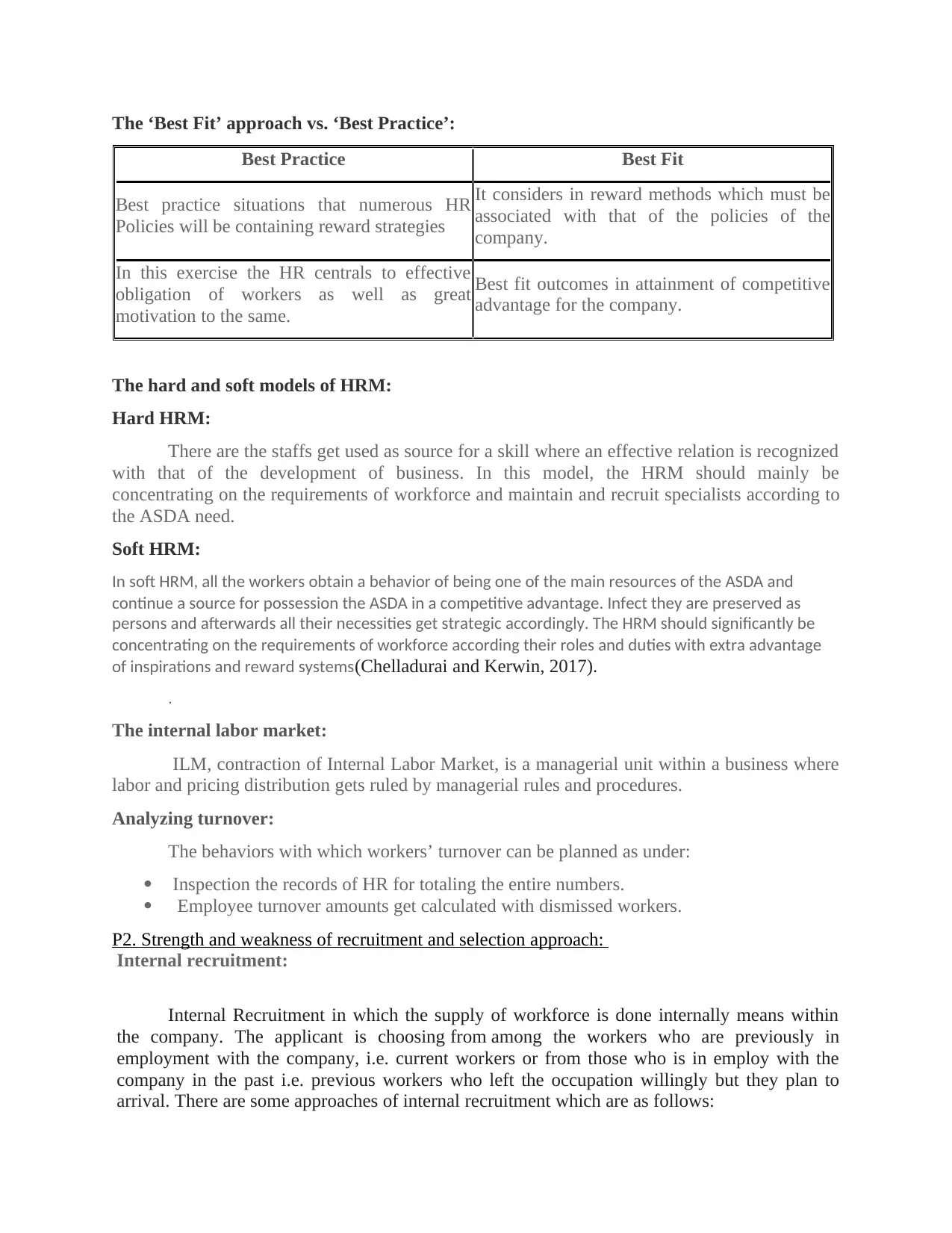
The ‘Best Fit’ approach vs. ‘Best Practice’:
Best Practice Best Fit
Best practice situations that numerous HR
Policies will be containing reward strategies
It considers in reward methods which must be
associated with that of the policies of the
company.
In this exercise the HR centrals to effective
obligation of workers as well as great
motivation to the same.
Best fit outcomes in attainment of competitive
advantage for the company.
The hard and soft models of HRM:
Hard HRM:
There are the staffs get used as source for a skill where an effective relation is recognized
with that of the development of business. In this model, the HRM should mainly be
concentrating on the requirements of workforce and maintain and recruit specialists according to
the ASDA need.
Soft HRM:
In soft HRM, all the workers obtain a behavior of being one of the main resources of the ASDA and
continue a source for possession the ASDA in a competitive advantage. Infect they are preserved as
persons and afterwards all their necessities get strategic accordingly. The HRM should significantly be
concentrating on the requirements of workforce according their roles and duties with extra advantage
of inspirations and reward systems(Chelladurai and Kerwin, 2017).
.
The internal labor market:
ILM, contraction of Internal Labor Market, is a managerial unit within a business where
labor and pricing distribution gets ruled by managerial rules and procedures.
Analyzing turnover:
The behaviors with which workers’ turnover can be planned as under:
Inspection the records of HR for totaling the entire numbers.
Employee turnover amounts get calculated with dismissed workers.
P2. Strength and weakness of recruitment and selection approach:
Internal recruitment:
Internal Recruitment in which the supply of workforce is done internally means within
the company. The applicant is choosing from among the workers who are previously in
employment with the company, i.e. current workers or from those who is in employ with the
company in the past i.e. previous workers who left the occupation willingly but they plan to
arrival. There are some approaches of internal recruitment which are as follows:
Best Practice Best Fit
Best practice situations that numerous HR
Policies will be containing reward strategies
It considers in reward methods which must be
associated with that of the policies of the
company.
In this exercise the HR centrals to effective
obligation of workers as well as great
motivation to the same.
Best fit outcomes in attainment of competitive
advantage for the company.
The hard and soft models of HRM:
Hard HRM:
There are the staffs get used as source for a skill where an effective relation is recognized
with that of the development of business. In this model, the HRM should mainly be
concentrating on the requirements of workforce and maintain and recruit specialists according to
the ASDA need.
Soft HRM:
In soft HRM, all the workers obtain a behavior of being one of the main resources of the ASDA and
continue a source for possession the ASDA in a competitive advantage. Infect they are preserved as
persons and afterwards all their necessities get strategic accordingly. The HRM should significantly be
concentrating on the requirements of workforce according their roles and duties with extra advantage
of inspirations and reward systems(Chelladurai and Kerwin, 2017).
.
The internal labor market:
ILM, contraction of Internal Labor Market, is a managerial unit within a business where
labor and pricing distribution gets ruled by managerial rules and procedures.
Analyzing turnover:
The behaviors with which workers’ turnover can be planned as under:
Inspection the records of HR for totaling the entire numbers.
Employee turnover amounts get calculated with dismissed workers.
P2. Strength and weakness of recruitment and selection approach:
Internal recruitment:
Internal Recruitment in which the supply of workforce is done internally means within
the company. The applicant is choosing from among the workers who are previously in
employment with the company, i.e. current workers or from those who is in employ with the
company in the past i.e. previous workers who left the occupation willingly but they plan to
arrival. There are some approaches of internal recruitment which are as follows:
Paraphrase This Document
Need a fresh take? Get an instant paraphrase of this document with our AI Paraphraser
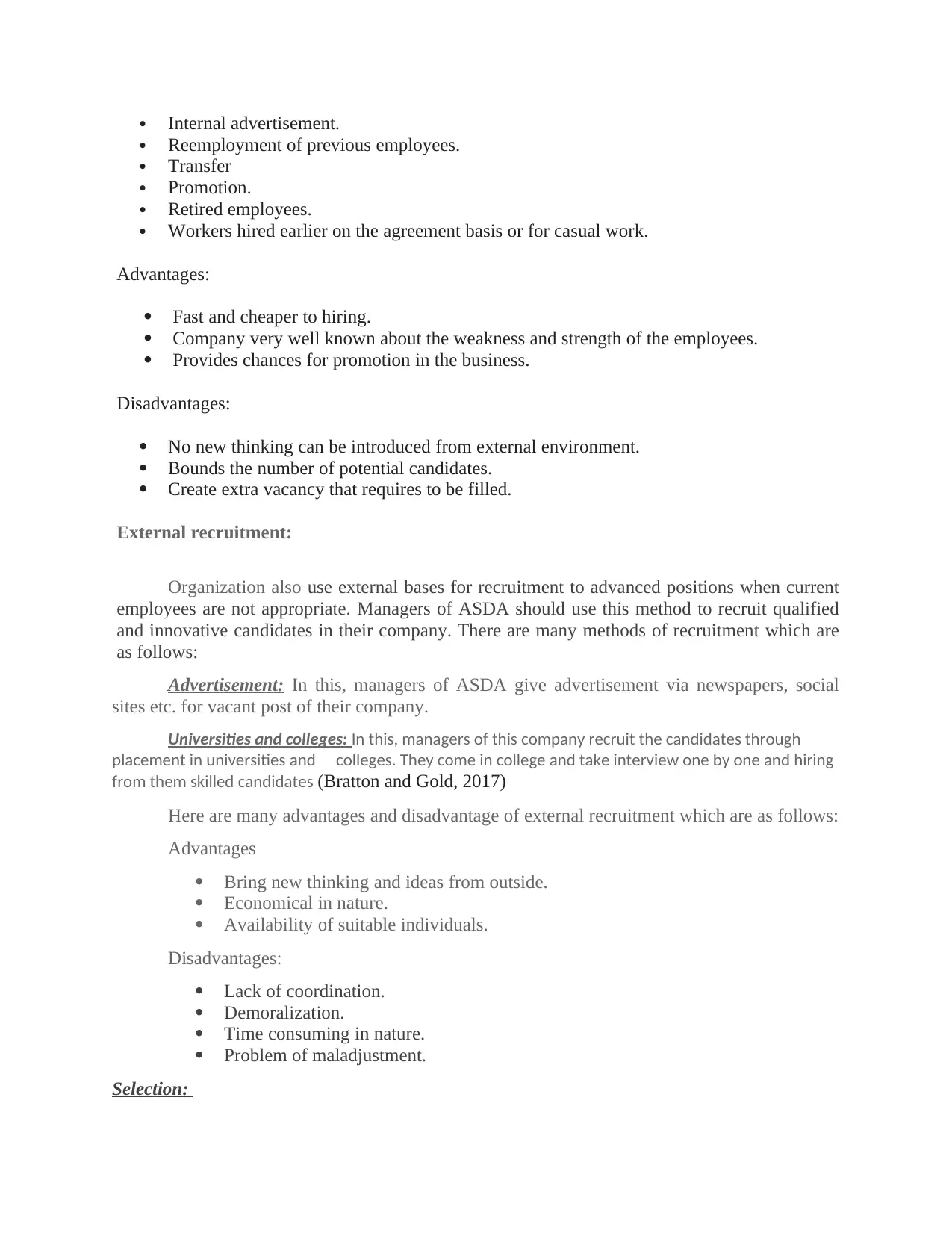
Internal advertisement.
Reemployment of previous employees.
Transfer
Promotion.
Retired employees.
Workers hired earlier on the agreement basis or for casual work.
Advantages:
Fast and cheaper to hiring.
Company very well known about the weakness and strength of the employees.
Provides chances for promotion in the business.
Disadvantages:
No new thinking can be introduced from external environment.
Bounds the number of potential candidates.
Create extra vacancy that requires to be filled.
External recruitment:
Organization also use external bases for recruitment to advanced positions when current
employees are not appropriate. Managers of ASDA should use this method to recruit qualified
and innovative candidates in their company. There are many methods of recruitment which are
as follows:
Advertisement: In this, managers of ASDA give advertisement via newspapers, social
sites etc. for vacant post of their company.
Universities and colleges: In this, managers of this company recruit the candidates through
placement in universities and colleges. They come in college and take interview one by one and hiring
from them skilled candidates (Bratton and Gold, 2017)
Here are many advantages and disadvantage of external recruitment which are as follows:
Advantages
Bring new thinking and ideas from outside.
Economical in nature.
Availability of suitable individuals.
Disadvantages:
Lack of coordination.
Demoralization.
Time consuming in nature.
Problem of maladjustment.
Selection:
Reemployment of previous employees.
Transfer
Promotion.
Retired employees.
Workers hired earlier on the agreement basis or for casual work.
Advantages:
Fast and cheaper to hiring.
Company very well known about the weakness and strength of the employees.
Provides chances for promotion in the business.
Disadvantages:
No new thinking can be introduced from external environment.
Bounds the number of potential candidates.
Create extra vacancy that requires to be filled.
External recruitment:
Organization also use external bases for recruitment to advanced positions when current
employees are not appropriate. Managers of ASDA should use this method to recruit qualified
and innovative candidates in their company. There are many methods of recruitment which are
as follows:
Advertisement: In this, managers of ASDA give advertisement via newspapers, social
sites etc. for vacant post of their company.
Universities and colleges: In this, managers of this company recruit the candidates through
placement in universities and colleges. They come in college and take interview one by one and hiring
from them skilled candidates (Bratton and Gold, 2017)
Here are many advantages and disadvantage of external recruitment which are as follows:
Advantages
Bring new thinking and ideas from outside.
Economical in nature.
Availability of suitable individuals.
Disadvantages:
Lack of coordination.
Demoralization.
Time consuming in nature.
Problem of maladjustment.
Selection:
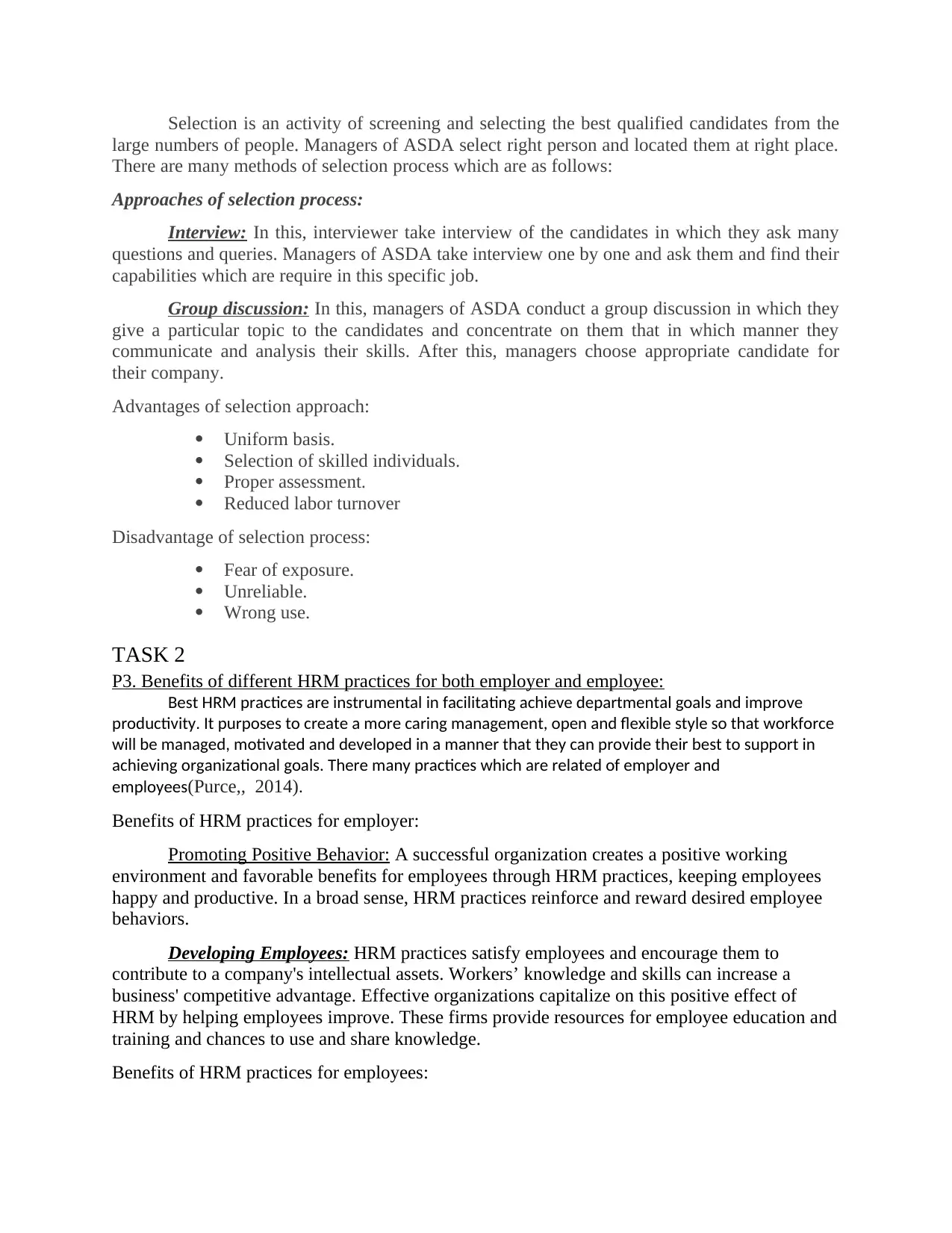
Selection is an activity of screening and selecting the best qualified candidates from the
large numbers of people. Managers of ASDA select right person and located them at right place.
There are many methods of selection process which are as follows:
Approaches of selection process:
Interview: In this, interviewer take interview of the candidates in which they ask many
questions and queries. Managers of ASDA take interview one by one and ask them and find their
capabilities which are require in this specific job.
Group discussion: In this, managers of ASDA conduct a group discussion in which they
give a particular topic to the candidates and concentrate on them that in which manner they
communicate and analysis their skills. After this, managers choose appropriate candidate for
their company.
Advantages of selection approach:
Uniform basis.
Selection of skilled individuals.
Proper assessment.
Reduced labor turnover
Disadvantage of selection process:
Fear of exposure.
Unreliable.
Wrong use.
TASK 2
P3. Benefits of different HRM practices for both employer and employee:
Best HRM practices are instrumental in facilitating achieve departmental goals and improve
productivity. It purposes to create a more caring management, open and flexible style so that workforce
will be managed, motivated and developed in a manner that they can provide their best to support in
achieving organizational goals. There many practices which are related of employer and
employees(Purce,, 2014).
Benefits of HRM practices for employer:
Promoting Positive Behavior: A successful organization creates a positive working
environment and favorable benefits for employees through HRM practices, keeping employees
happy and productive. In a broad sense, HRM practices reinforce and reward desired employee
behaviors.
Developing Employees: HRM practices satisfy employees and encourage them to
contribute to a company's intellectual assets. Workers’ knowledge and skills can increase a
business' competitive advantage. Effective organizations capitalize on this positive effect of
HRM by helping employees improve. These firms provide resources for employee education and
training and chances to use and share knowledge.
Benefits of HRM practices for employees:
large numbers of people. Managers of ASDA select right person and located them at right place.
There are many methods of selection process which are as follows:
Approaches of selection process:
Interview: In this, interviewer take interview of the candidates in which they ask many
questions and queries. Managers of ASDA take interview one by one and ask them and find their
capabilities which are require in this specific job.
Group discussion: In this, managers of ASDA conduct a group discussion in which they
give a particular topic to the candidates and concentrate on them that in which manner they
communicate and analysis their skills. After this, managers choose appropriate candidate for
their company.
Advantages of selection approach:
Uniform basis.
Selection of skilled individuals.
Proper assessment.
Reduced labor turnover
Disadvantage of selection process:
Fear of exposure.
Unreliable.
Wrong use.
TASK 2
P3. Benefits of different HRM practices for both employer and employee:
Best HRM practices are instrumental in facilitating achieve departmental goals and improve
productivity. It purposes to create a more caring management, open and flexible style so that workforce
will be managed, motivated and developed in a manner that they can provide their best to support in
achieving organizational goals. There many practices which are related of employer and
employees(Purce,, 2014).
Benefits of HRM practices for employer:
Promoting Positive Behavior: A successful organization creates a positive working
environment and favorable benefits for employees through HRM practices, keeping employees
happy and productive. In a broad sense, HRM practices reinforce and reward desired employee
behaviors.
Developing Employees: HRM practices satisfy employees and encourage them to
contribute to a company's intellectual assets. Workers’ knowledge and skills can increase a
business' competitive advantage. Effective organizations capitalize on this positive effect of
HRM by helping employees improve. These firms provide resources for employee education and
training and chances to use and share knowledge.
Benefits of HRM practices for employees:
⊘ This is a preview!⊘
Do you want full access?
Subscribe today to unlock all pages.

Trusted by 1+ million students worldwide

Improve employee turnover: High employee turnover hurts a company’s bottom line. It
cost twice as much as a current employee’s salary to find and train a new recruit. As a human
resource manager should know how to hire the right people for the company from the start.
Conflict resolutions: Workplace conflict is somewhat inevitable as employees have
different personalities, lifestyles and work ethic. While doing the human resource management
course, you’ll be taught how to handle conflict in the workplace and how to resolve it. They also
be taught how to handle the situation as professionally as possible (Arnaboldi, Lapsley, and
Steccolini, 2015).
Employee satisfaction: Human resource specialists are usually charged with the
responsibility of determining employee satisfaction. As a human resource management student,
they learn how to set up surveys, focus groups and interview strategies to help you determine
whether employees are content or not.
P4. Evaluate the effectiveness of different HRM practices:
HRM has been effective for ASDA in respect of increasing organizational productivity and profit.
Since the operation of HRM in the organization, it has achieved more output and revenue by the
following view:
Innovative and high performing employees: The HRM encourages inspired and
innovative environment and influence their workers for better services and of course all of these
creativities support ASDA to rise the output as well as the revenue.
Collaboration and sharing: Profitability and productivity of ASDA progresses magically
when others from the external the company freely cooperate and willingly share the effective
ideas and association tools. It is HRM which supports to the company to create formal
techniques to rise the way of the sharing process and collaboration.
Non-monetary factors to improve employees: team workers, leaders and managers of
ASDA provide nonmonetary aspects that rise employee excitement, energy, loyalty and
motivation. These factors involve recognition, challenge, praise, feedback, learning
opportunities, exposure etc. it is the HR of company that assure administrators know how to
efficiently apply these nonmonetary factors.
TASK 3
P5. Importance of employee relation:
The term 'employee relations' refers to a company's efforts to manage relationships
between employers and employees. An organization with a good employee relations program
provides fair and consistent treatment to all employees so they will be committed to their jobs
and loyal to the company. Such programs also aim to prevent and resolve problems arising from
situations at work.
Employee relations: It is a manner with which the management interacts and addresses each
employee. Maintaining a better relationship will be reducing any kind of workplace conflicts
along with some more advantages such as raising staff morale and increment of the entire
organization productivity. At ASDA, the different ways that get used for improvement of such
has been mentioned below:
cost twice as much as a current employee’s salary to find and train a new recruit. As a human
resource manager should know how to hire the right people for the company from the start.
Conflict resolutions: Workplace conflict is somewhat inevitable as employees have
different personalities, lifestyles and work ethic. While doing the human resource management
course, you’ll be taught how to handle conflict in the workplace and how to resolve it. They also
be taught how to handle the situation as professionally as possible (Arnaboldi, Lapsley, and
Steccolini, 2015).
Employee satisfaction: Human resource specialists are usually charged with the
responsibility of determining employee satisfaction. As a human resource management student,
they learn how to set up surveys, focus groups and interview strategies to help you determine
whether employees are content or not.
P4. Evaluate the effectiveness of different HRM practices:
HRM has been effective for ASDA in respect of increasing organizational productivity and profit.
Since the operation of HRM in the organization, it has achieved more output and revenue by the
following view:
Innovative and high performing employees: The HRM encourages inspired and
innovative environment and influence their workers for better services and of course all of these
creativities support ASDA to rise the output as well as the revenue.
Collaboration and sharing: Profitability and productivity of ASDA progresses magically
when others from the external the company freely cooperate and willingly share the effective
ideas and association tools. It is HRM which supports to the company to create formal
techniques to rise the way of the sharing process and collaboration.
Non-monetary factors to improve employees: team workers, leaders and managers of
ASDA provide nonmonetary aspects that rise employee excitement, energy, loyalty and
motivation. These factors involve recognition, challenge, praise, feedback, learning
opportunities, exposure etc. it is the HR of company that assure administrators know how to
efficiently apply these nonmonetary factors.
TASK 3
P5. Importance of employee relation:
The term 'employee relations' refers to a company's efforts to manage relationships
between employers and employees. An organization with a good employee relations program
provides fair and consistent treatment to all employees so they will be committed to their jobs
and loyal to the company. Such programs also aim to prevent and resolve problems arising from
situations at work.
Employee relations: It is a manner with which the management interacts and addresses each
employee. Maintaining a better relationship will be reducing any kind of workplace conflicts
along with some more advantages such as raising staff morale and increment of the entire
organization productivity. At ASDA, the different ways that get used for improvement of such
has been mentioned below:
Paraphrase This Document
Need a fresh take? Get an instant paraphrase of this document with our AI Paraphraser

Improved Communication: Maintaining a proper hierarchy, the management makes sure that
all the employees are having access to every level so that they can feel their priority of service as
well as their importance within the organization.
Career Development: For decrement of employee turnover, the company have adopted certain
roles in terms of staff career development(Collings, Wood and Szamosi, 2018).
Sharing of vision: For making each and every employee feel special, importantly the company
is needed to share the plan of the company with their every staff.
Strategies for building and improving employee relations and engagement:
The strategies include:
Using a survey that acts rightly for assessing employee engagement.
Focusing on the employee engagement at the organizational and local levels.
Selection of the right managers.
Coaching of managers and additionally holding them accountable for the purpose of employee
engagement.
Defining engagement goals in everyday terms.
P6. Key elements of employee legislation:
There are certain rules and regulation that are required by the company and its human
resource management team that are conducted by following all the legislation. Best way need
comply with these rules and regulations for the purpose of execution of the operations of the
organization within the legal framework. These legal and regulatory frameworks on the
human resource management are mentioned below-
National minimum wages act 1998- It is important that human resource management team pay
at least the minimum wages that are directed by the act to the labors and task force. If they do not
pay them accordingly then legal actions can be taken against the company and its department.
The minimum wages are stipulated in the act and it’s obligatory for the human resource to follow
them. Organizations need to follow the wage rates which are being decided or stated in the
act(Sheehan, 2014)
.
Equal pay act 1970- Human resource team is required to pay equal pay without
discriminating on the basis of the gender, race, religion, caste etc. but is then also management team
follows the discrimination then they are eligible for the legal actions. This act ensures that the equal
payment is made to the employees without executing discriminatory practices which results in
unethical practices at the workplace of the organization.
Sex Discrimination Act 1997- this act states that organizations need to ensure that no
discriminatory practices are being carried out in an organization on the basis of the sex of the
employee.
all the employees are having access to every level so that they can feel their priority of service as
well as their importance within the organization.
Career Development: For decrement of employee turnover, the company have adopted certain
roles in terms of staff career development(Collings, Wood and Szamosi, 2018).
Sharing of vision: For making each and every employee feel special, importantly the company
is needed to share the plan of the company with their every staff.
Strategies for building and improving employee relations and engagement:
The strategies include:
Using a survey that acts rightly for assessing employee engagement.
Focusing on the employee engagement at the organizational and local levels.
Selection of the right managers.
Coaching of managers and additionally holding them accountable for the purpose of employee
engagement.
Defining engagement goals in everyday terms.
P6. Key elements of employee legislation:
There are certain rules and regulation that are required by the company and its human
resource management team that are conducted by following all the legislation. Best way need
comply with these rules and regulations for the purpose of execution of the operations of the
organization within the legal framework. These legal and regulatory frameworks on the
human resource management are mentioned below-
National minimum wages act 1998- It is important that human resource management team pay
at least the minimum wages that are directed by the act to the labors and task force. If they do not
pay them accordingly then legal actions can be taken against the company and its department.
The minimum wages are stipulated in the act and it’s obligatory for the human resource to follow
them. Organizations need to follow the wage rates which are being decided or stated in the
act(Sheehan, 2014)
.
Equal pay act 1970- Human resource team is required to pay equal pay without
discriminating on the basis of the gender, race, religion, caste etc. but is then also management team
follows the discrimination then they are eligible for the legal actions. This act ensures that the equal
payment is made to the employees without executing discriminatory practices which results in
unethical practices at the workplace of the organization.
Sex Discrimination Act 1997- this act states that organizations need to ensure that no
discriminatory practices are being carried out in an organization on the basis of the sex of the
employee.
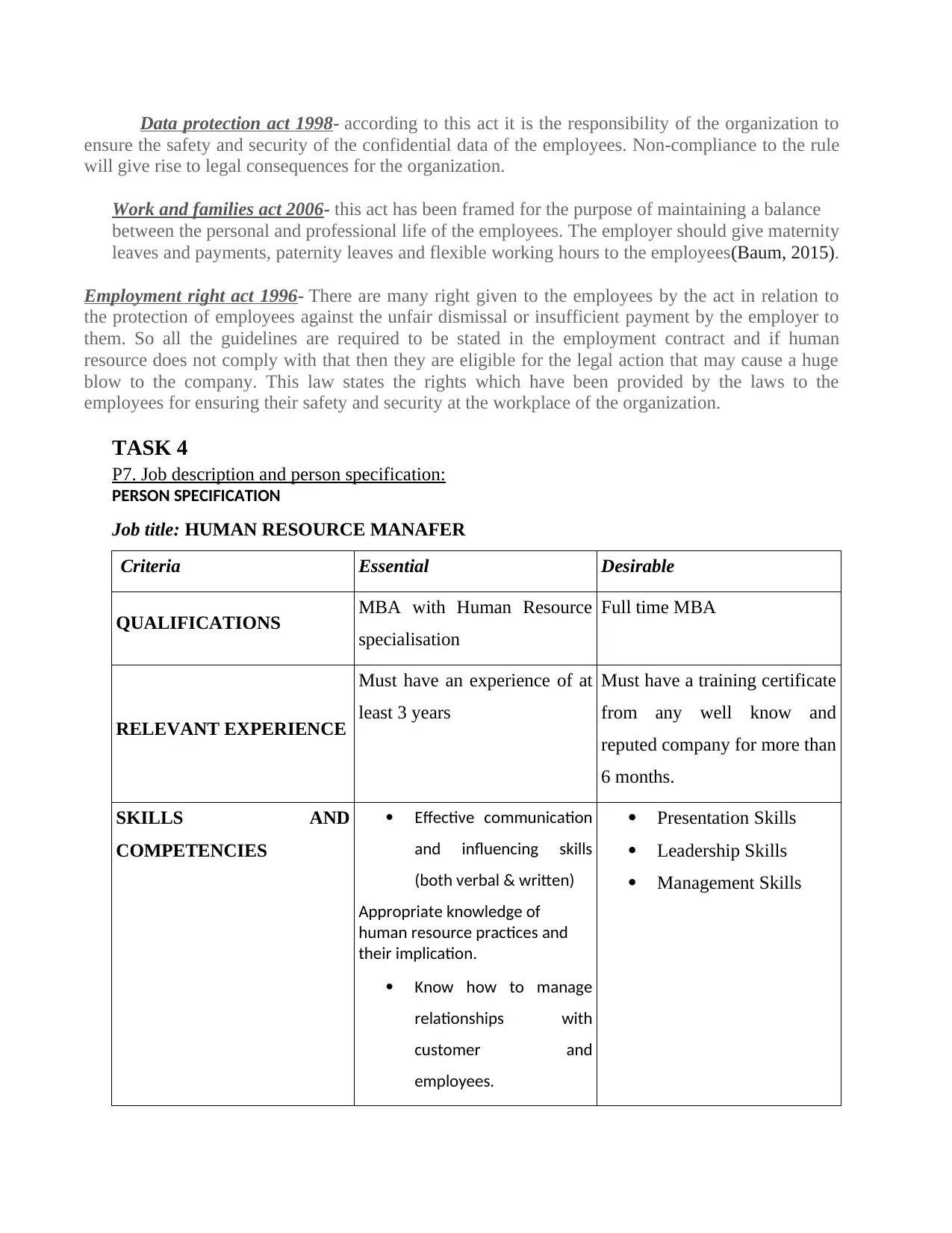
Data protection act 1998- according to this act it is the responsibility of the organization to
ensure the safety and security of the confidential data of the employees. Non-compliance to the rule
will give rise to legal consequences for the organization.
Work and families act 2006- this act has been framed for the purpose of maintaining a balance
between the personal and professional life of the employees. The employer should give maternity
leaves and payments, paternity leaves and flexible working hours to the employees(Baum, 2015).
Employment right act 1996- There are many right given to the employees by the act in relation to
the protection of employees against the unfair dismissal or insufficient payment by the employer to
them. So all the guidelines are required to be stated in the employment contract and if human
resource does not comply with that then they are eligible for the legal action that may cause a huge
blow to the company. This law states the rights which have been provided by the laws to the
employees for ensuring their safety and security at the workplace of the organization.
TASK 4
P7. Job description and person specification:
PERSON SPECIFICATION
Job title: HUMAN RESOURCE MANAFER
Criteria Essential Desirable
QUALIFICATIONS MBA with Human Resource
specialisation
Full time MBA
RELEVANT EXPERIENCE
Must have an experience of at
least 3 years
Must have a training certificate
from any well know and
reputed company for more than
6 months.
SKILLS AND
COMPETENCIES
Effective communication
and influencing skills
(both verbal & written)
Appropriate knowledge of
human resource practices and
their implication.
Know how to manage
relationships with
customer and
employees.
Presentation Skills
Leadership Skills
Management Skills
ensure the safety and security of the confidential data of the employees. Non-compliance to the rule
will give rise to legal consequences for the organization.
Work and families act 2006- this act has been framed for the purpose of maintaining a balance
between the personal and professional life of the employees. The employer should give maternity
leaves and payments, paternity leaves and flexible working hours to the employees(Baum, 2015).
Employment right act 1996- There are many right given to the employees by the act in relation to
the protection of employees against the unfair dismissal or insufficient payment by the employer to
them. So all the guidelines are required to be stated in the employment contract and if human
resource does not comply with that then they are eligible for the legal action that may cause a huge
blow to the company. This law states the rights which have been provided by the laws to the
employees for ensuring their safety and security at the workplace of the organization.
TASK 4
P7. Job description and person specification:
PERSON SPECIFICATION
Job title: HUMAN RESOURCE MANAFER
Criteria Essential Desirable
QUALIFICATIONS MBA with Human Resource
specialisation
Full time MBA
RELEVANT EXPERIENCE
Must have an experience of at
least 3 years
Must have a training certificate
from any well know and
reputed company for more than
6 months.
SKILLS AND
COMPETENCIES
Effective communication
and influencing skills
(both verbal & written)
Appropriate knowledge of
human resource practices and
their implication.
Know how to manage
relationships with
customer and
employees.
Presentation Skills
Leadership Skills
Management Skills
⊘ This is a preview!⊘
Do you want full access?
Subscribe today to unlock all pages.

Trusted by 1+ million students worldwide
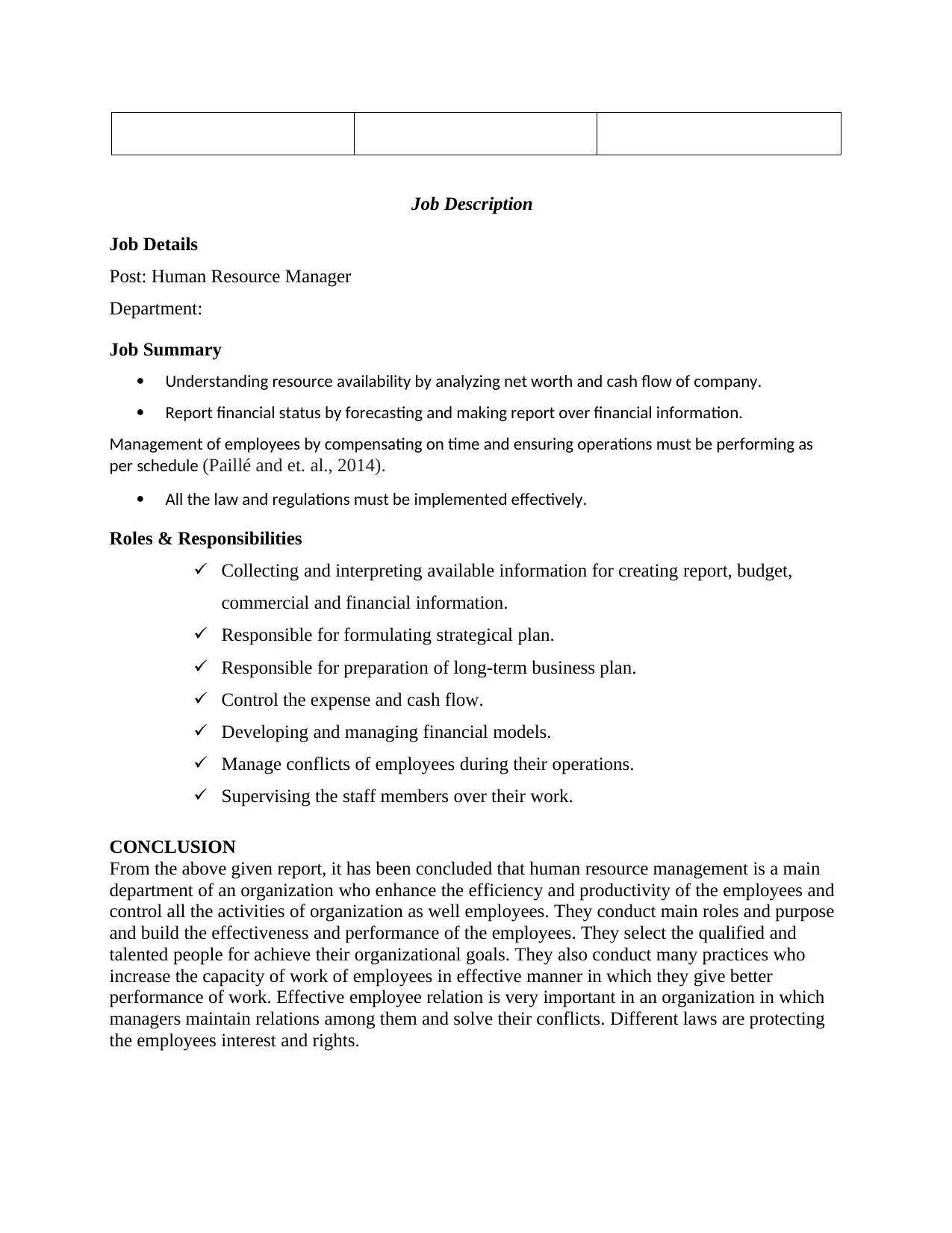
Job Description
Job Details
Post: Human Resource Manager
Department:
Job Summary
Understanding resource availability by analyzing net worth and cash flow of company.
Report financial status by forecasting and making report over financial information.
Management of employees by compensating on time and ensuring operations must be performing as
per schedule (Paillé and et. al., 2014).
All the law and regulations must be implemented effectively.
Roles & Responsibilities
Collecting and interpreting available information for creating report, budget,
commercial and financial information.
Responsible for formulating strategical plan.
Responsible for preparation of long-term business plan.
Control the expense and cash flow.
Developing and managing financial models.
Manage conflicts of employees during their operations.
Supervising the staff members over their work.
CONCLUSION
From the above given report, it has been concluded that human resource management is a main
department of an organization who enhance the efficiency and productivity of the employees and
control all the activities of organization as well employees. They conduct main roles and purpose
and build the effectiveness and performance of the employees. They select the qualified and
talented people for achieve their organizational goals. They also conduct many practices who
increase the capacity of work of employees in effective manner in which they give better
performance of work. Effective employee relation is very important in an organization in which
managers maintain relations among them and solve their conflicts. Different laws are protecting
the employees interest and rights.
Job Details
Post: Human Resource Manager
Department:
Job Summary
Understanding resource availability by analyzing net worth and cash flow of company.
Report financial status by forecasting and making report over financial information.
Management of employees by compensating on time and ensuring operations must be performing as
per schedule (Paillé and et. al., 2014).
All the law and regulations must be implemented effectively.
Roles & Responsibilities
Collecting and interpreting available information for creating report, budget,
commercial and financial information.
Responsible for formulating strategical plan.
Responsible for preparation of long-term business plan.
Control the expense and cash flow.
Developing and managing financial models.
Manage conflicts of employees during their operations.
Supervising the staff members over their work.
CONCLUSION
From the above given report, it has been concluded that human resource management is a main
department of an organization who enhance the efficiency and productivity of the employees and
control all the activities of organization as well employees. They conduct main roles and purpose
and build the effectiveness and performance of the employees. They select the qualified and
talented people for achieve their organizational goals. They also conduct many practices who
increase the capacity of work of employees in effective manner in which they give better
performance of work. Effective employee relation is very important in an organization in which
managers maintain relations among them and solve their conflicts. Different laws are protecting
the employees interest and rights.
Paraphrase This Document
Need a fresh take? Get an instant paraphrase of this document with our AI Paraphraser
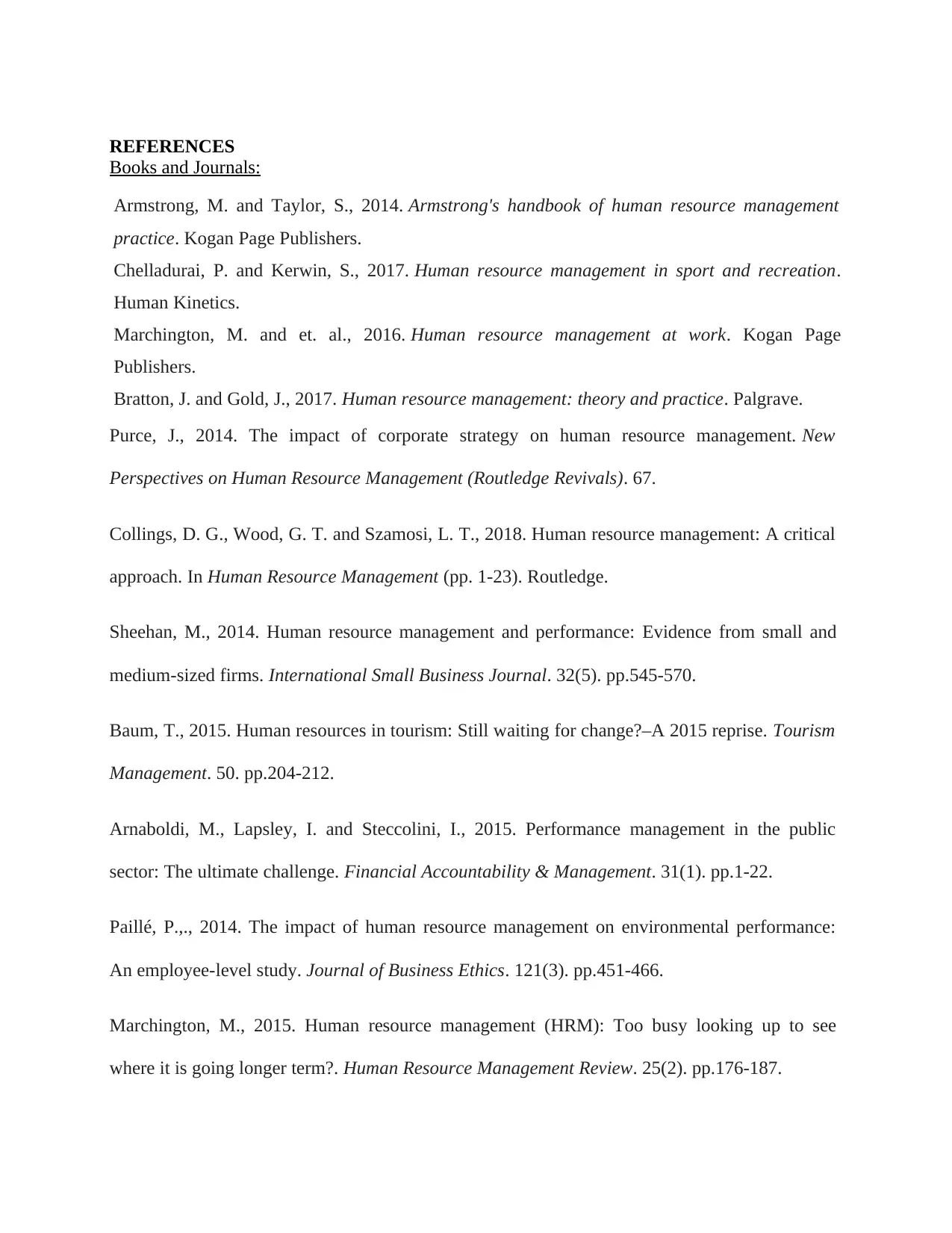
REFERENCES
Books and Journals:
Armstrong, M. and Taylor, S., 2014. Armstrong's handbook of human resource management
practice. Kogan Page Publishers.
Chelladurai, P. and Kerwin, S., 2017. Human resource management in sport and recreation.
Human Kinetics.
Marchington, M. and et. al., 2016. Human resource management at work. Kogan Page
Publishers.
Bratton, J. and Gold, J., 2017. Human resource management: theory and practice. Palgrave.
Purce, J., 2014. The impact of corporate strategy on human resource management. New
Perspectives on Human Resource Management (Routledge Revivals). 67.
Collings, D. G., Wood, G. T. and Szamosi, L. T., 2018. Human resource management: A critical
approach. In Human Resource Management (pp. 1-23). Routledge.
Sheehan, M., 2014. Human resource management and performance: Evidence from small and
medium-sized firms. International Small Business Journal. 32(5). pp.545-570.
Baum, T., 2015. Human resources in tourism: Still waiting for change?–A 2015 reprise. Tourism
Management. 50. pp.204-212.
Arnaboldi, M., Lapsley, I. and Steccolini, I., 2015. Performance management in the public
sector: The ultimate challenge. Financial Accountability & Management. 31(1). pp.1-22.
Paillé, P.,., 2014. The impact of human resource management on environmental performance:
An employee-level study. Journal of Business Ethics. 121(3). pp.451-466.
Marchington, M., 2015. Human resource management (HRM): Too busy looking up to see
where it is going longer term?. Human Resource Management Review. 25(2). pp.176-187.
Books and Journals:
Armstrong, M. and Taylor, S., 2014. Armstrong's handbook of human resource management
practice. Kogan Page Publishers.
Chelladurai, P. and Kerwin, S., 2017. Human resource management in sport and recreation.
Human Kinetics.
Marchington, M. and et. al., 2016. Human resource management at work. Kogan Page
Publishers.
Bratton, J. and Gold, J., 2017. Human resource management: theory and practice. Palgrave.
Purce, J., 2014. The impact of corporate strategy on human resource management. New
Perspectives on Human Resource Management (Routledge Revivals). 67.
Collings, D. G., Wood, G. T. and Szamosi, L. T., 2018. Human resource management: A critical
approach. In Human Resource Management (pp. 1-23). Routledge.
Sheehan, M., 2014. Human resource management and performance: Evidence from small and
medium-sized firms. International Small Business Journal. 32(5). pp.545-570.
Baum, T., 2015. Human resources in tourism: Still waiting for change?–A 2015 reprise. Tourism
Management. 50. pp.204-212.
Arnaboldi, M., Lapsley, I. and Steccolini, I., 2015. Performance management in the public
sector: The ultimate challenge. Financial Accountability & Management. 31(1). pp.1-22.
Paillé, P.,., 2014. The impact of human resource management on environmental performance:
An employee-level study. Journal of Business Ethics. 121(3). pp.451-466.
Marchington, M., 2015. Human resource management (HRM): Too busy looking up to see
where it is going longer term?. Human Resource Management Review. 25(2). pp.176-187.
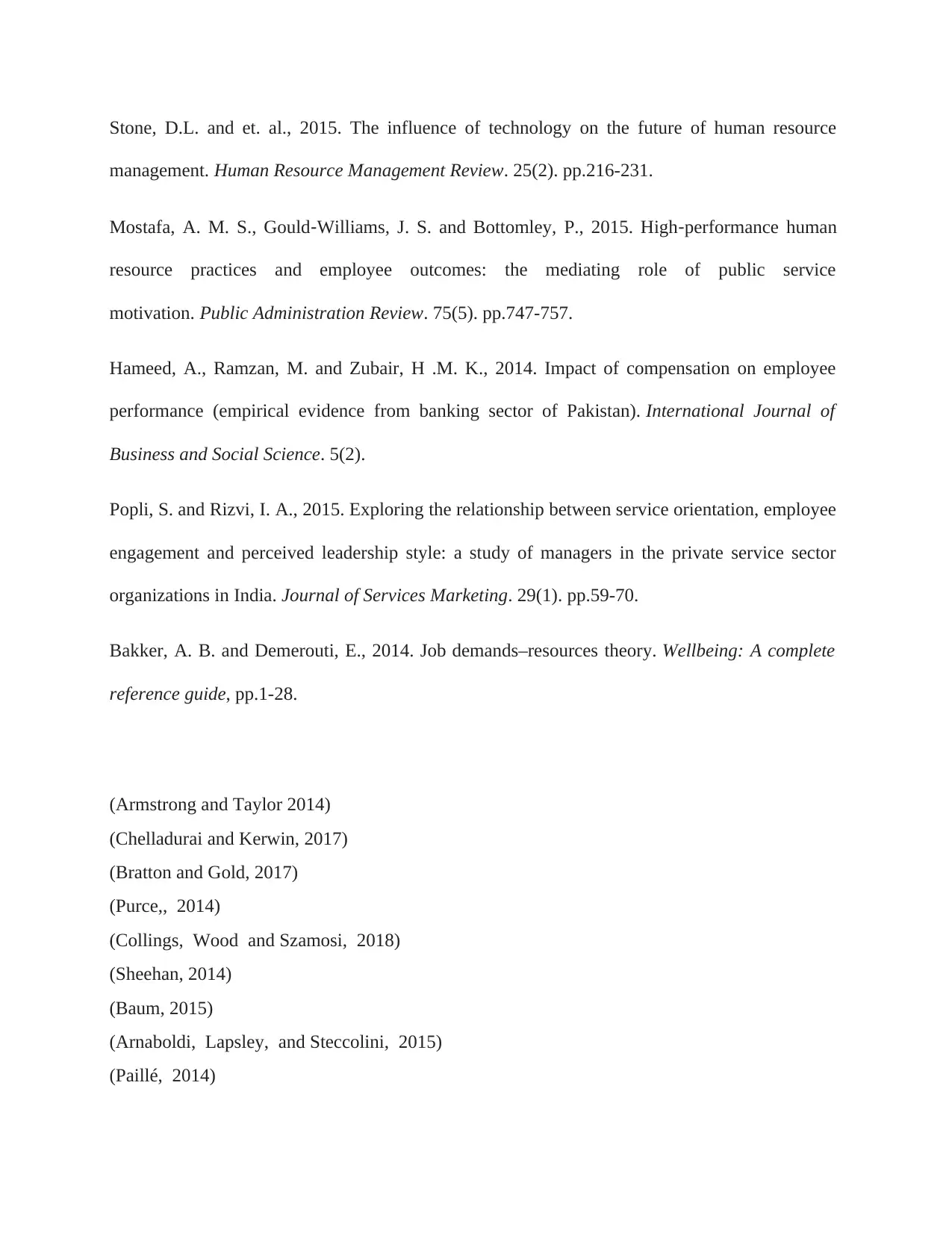
Stone, D.L. and et. al., 2015. The influence of technology on the future of human resource
management. Human Resource Management Review. 25(2). pp.216-231.
Mostafa, A. M. S., Gould‐Williams, J. S. and Bottomley, P., 2015. High‐performance human
resource practices and employee outcomes: the mediating role of public service
motivation. Public Administration Review. 75(5). pp.747-757.
Hameed, A., Ramzan, M. and Zubair, H .M. K., 2014. Impact of compensation on employee
performance (empirical evidence from banking sector of Pakistan). International Journal of
Business and Social Science. 5(2).
Popli, S. and Rizvi, I. A., 2015. Exploring the relationship between service orientation, employee
engagement and perceived leadership style: a study of managers in the private service sector
organizations in India. Journal of Services Marketing. 29(1). pp.59-70.
Bakker, A. B. and Demerouti, E., 2014. Job demands–resources theory. Wellbeing: A complete
reference guide, pp.1-28.
(Armstrong and Taylor 2014)
(Chelladurai and Kerwin, 2017)
(Bratton and Gold, 2017)
(Purce,, 2014)
(Collings, Wood and Szamosi, 2018)
(Sheehan, 2014)
(Baum, 2015)
(Arnaboldi, Lapsley, and Steccolini, 2015)
(Paillé, 2014)
management. Human Resource Management Review. 25(2). pp.216-231.
Mostafa, A. M. S., Gould‐Williams, J. S. and Bottomley, P., 2015. High‐performance human
resource practices and employee outcomes: the mediating role of public service
motivation. Public Administration Review. 75(5). pp.747-757.
Hameed, A., Ramzan, M. and Zubair, H .M. K., 2014. Impact of compensation on employee
performance (empirical evidence from banking sector of Pakistan). International Journal of
Business and Social Science. 5(2).
Popli, S. and Rizvi, I. A., 2015. Exploring the relationship between service orientation, employee
engagement and perceived leadership style: a study of managers in the private service sector
organizations in India. Journal of Services Marketing. 29(1). pp.59-70.
Bakker, A. B. and Demerouti, E., 2014. Job demands–resources theory. Wellbeing: A complete
reference guide, pp.1-28.
(Armstrong and Taylor 2014)
(Chelladurai and Kerwin, 2017)
(Bratton and Gold, 2017)
(Purce,, 2014)
(Collings, Wood and Szamosi, 2018)
(Sheehan, 2014)
(Baum, 2015)
(Arnaboldi, Lapsley, and Steccolini, 2015)
(Paillé, 2014)
⊘ This is a preview!⊘
Do you want full access?
Subscribe today to unlock all pages.

Trusted by 1+ million students worldwide
1 out of 13
Related Documents
Your All-in-One AI-Powered Toolkit for Academic Success.
+13062052269
info@desklib.com
Available 24*7 on WhatsApp / Email
![[object Object]](/_next/static/media/star-bottom.7253800d.svg)
Unlock your academic potential
Copyright © 2020–2025 A2Z Services. All Rights Reserved. Developed and managed by ZUCOL.





